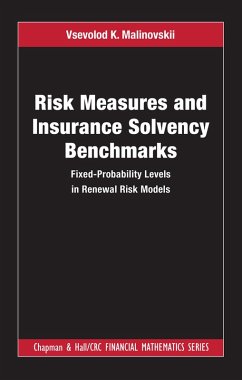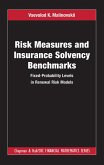Risk Measures and Insurance Solvency Benchmarks (eBook, PDF)
Fixed-Probability Levels in Renewal Risk Models


Alle Infos zum eBook verschenken

Risk Measures and Insurance Solvency Benchmarks (eBook, PDF)
Fixed-Probability Levels in Renewal Risk Models
- Format: PDF
- Merkliste
- Auf die Merkliste
- Bewerten Bewerten
- Teilen
- Produkt teilen
- Produkterinnerung
- Produkterinnerung

Hier können Sie sich einloggen

Bitte loggen Sie sich zunächst in Ihr Kundenkonto ein oder registrieren Sie sich bei bücher.de, um das eBook-Abo tolino select nutzen zu können.
Risk Measures and Insurance Solvency Benchmarks: Fixed-Probability Levels in Renewal Risk Models is written for academics and practitioners who are concerned about potential weaknesses of the Solvency II regulatory system. It is also intended for readers who are interested in pure and applied probability, have a taste for classical and asymptotic analysis, and are motivated to delve into rather intensive calculations.
The formal prerequisite for this book is a good background in analysis. The desired prerequisite is some degree of probability training, but someone with knowledge of the…mehr
- Geräte: PC
- mit Kopierschutz
- eBook Hilfe
![Risk Measures and Insurance Solvency Benchmarks (eBook, ePUB) Risk Measures and Insurance Solvency Benchmarks (eBook, ePUB)]() Vsevolod K. MalinovskiiRisk Measures and Insurance Solvency Benchmarks (eBook, ePUB)46,95 €
Vsevolod K. MalinovskiiRisk Measures and Insurance Solvency Benchmarks (eBook, ePUB)46,95 €![Calculus for Business and Economics (eBook, PDF) Calculus for Business and Economics (eBook, PDF)]() Jon Pierre FortneyCalculus for Business and Economics (eBook, PDF)49,95 €
Jon Pierre FortneyCalculus for Business and Economics (eBook, PDF)49,95 €![Random Probability Measures on Polish Spaces (eBook, PDF) Random Probability Measures on Polish Spaces (eBook, PDF)]() Hans CrauelRandom Probability Measures on Polish Spaces (eBook, PDF)63,95 €
Hans CrauelRandom Probability Measures on Polish Spaces (eBook, PDF)63,95 €![Stochastic Processes and Functional Analysis (eBook, PDF) Stochastic Processes and Functional Analysis (eBook, PDF)]() Stochastic Processes and Functional Analysis (eBook, PDF)285,95 €
Stochastic Processes and Functional Analysis (eBook, PDF)285,95 €![Banach-Space Operators On C*-Probability Spaces Generated by Multi Semicircular Elements (eBook, PDF) Banach-Space Operators On C*-Probability Spaces Generated by Multi Semicircular Elements (eBook, PDF)]() Ilwoo ChoBanach-Space Operators On C*-Probability Spaces Generated by Multi Semicircular Elements (eBook, PDF)157,95 €
Ilwoo ChoBanach-Space Operators On C*-Probability Spaces Generated by Multi Semicircular Elements (eBook, PDF)157,95 €![Problems and Examples in Differential Equations (eBook, PDF) Problems and Examples in Differential Equations (eBook, PDF)]() Piotr BilerProblems and Examples in Differential Equations (eBook, PDF)113,95 €
Piotr BilerProblems and Examples in Differential Equations (eBook, PDF)113,95 €![Mathematical Analysis and Optimization for Economists (eBook, PDF) Mathematical Analysis and Optimization for Economists (eBook, PDF)]() Michael J. PanikMathematical Analysis and Optimization for Economists (eBook, PDF)46,95 €
Michael J. PanikMathematical Analysis and Optimization for Economists (eBook, PDF)46,95 €-
-
-
The formal prerequisite for this book is a good background in analysis. The desired prerequisite is some degree of probability training, but someone with knowledge of the classical real-variable theory, including asymptotic methods, will also find this book interesting. For those who find the proofs too complicated, it may be reassuring that most results in this book are formulated in rather elementary terms. This book can also be used as reading material for basic courses in risk measures, insurance mathematics, and applied probability. The material of this book was partly used by the author for his courses in several universities in Moscow, Copenhagen University, and in the University of Montreal.
Features
- Requires only minimal mathematical prerequisites in analysis and probability
- Suitable for researchers and postgraduate students in related fields
- Could be used as a supplement to courses in risk measures, insurance mathematics and applied probability.
Dieser Download kann aus rechtlichen Gründen nur mit Rechnungsadresse in A, B, BG, CY, CZ, D, DK, EW, E, FIN, F, GR, HR, H, IRL, I, LT, L, LR, M, NL, PL, P, R, S, SLO, SK ausgeliefert werden.
- Produktdetails
- Verlag: Taylor & Francis eBooks
- Seitenzahl: 340
- Erscheinungstermin: 21. Juli 2021
- Englisch
- ISBN-13: 9781000411072
- Artikelnr.: 62050148
- Verlag: Taylor & Francis eBooks
- Seitenzahl: 340
- Erscheinungstermin: 21. Juli 2021
- Englisch
- ISBN-13: 9781000411072
- Artikelnr.: 62050148
- Herstellerkennzeichnung Die Herstellerinformationen sind derzeit nicht verfügbar.
He was Visiting Professor at the University of Copenhagen in 1993 and in 1998, and at the University of Montreal in 2001. He has authored Insurance Planning Models: Price Competition and Regulation of Financial Stability and Level-Crossing Problems and Inverse Gaussian Distributions: Closed-Form Results and Approximations. Professor Malinovskii's main research interests are in Applied Probability and in Mathematical Statistics.
and portfolio management. 1.2. Risk measures in Solvency II system. 1.3.
Risk measures in risk theory. 1.4. Aim and structure of the book. 1.5.
Readers, to whom this book is addressed. Problems. 2. Fixed-probability
level in a diffusion model. 2.1. Diffusion model: an auxiliary tool. 2.2.
Direct level-crossing problem. 2.3. Inverse level-crossing problem. 2.4.
Asymptotic behaviour of fixed-probability level. 2.5. Primary upper bounds
on fixed-probability level. 2.6. Elaborated upper bounds on
fixed-probability level. 2.7. Conclusions and perspectives. Problems. 3.
Fixed-probability level in an exceptional renewal model. 3.1. Exponential
renewal model: an exceptional case. 3.2. Direct level-crossing problem.
3.3. Inverse level-crossing problem. 3.4. Asymptotic behaviour of
fixed-probability level. 3.5. Primary upper bounds on fixed-probability
level. 3.6. Elaborated upper bounds on fixed-probability level. 3.7.
Conclusions. Problems. 4. Implicit function defined by M-equation. 4.1.
Analytical properties of core integral expression. 4.2. Proximity between
Mu;c(t) and Mu;c(t j v). 4.3. Analytical properties of M-level. Problem.
5. Fixed-probability level in general renewal model. 5.1. General renewal
model: main framework. 5.2. Direct level-crossing problem. 5.3. Inverse
level-crossing problem. 5.4. Primary upper bounds on fixed-probability
level. 5.5. Proximity to M-level. 5.6. Conclusion. Problem. 6. Case study:
numerical evaluation of fixed-probability Level. 6.1. Distributions of T
and Y selected for numerical calculations. 6.2. Simulation in
level-crossing problems. 6.3. Numerically calculated bounds on the
fixed-probability level. 6.4. Conclusion. Problems. 7. Probability
mechanism of insurance with migration and ERS-analysis. 7.1. Structural
model of insurance business: origin and purpose of ERS-analysis. 7.2. Price
competition, migration, and market price. 7.3. Compound Poisson risk model
with migration. 7.4. ERS-analysis, when Y is exponentially distributed.
7.5. ERS-analysis, when Y is generally distributed. 7.6. Conclusions.
Problems. A. Auxiliary results from analysis. B. Auxiliary results from
probability. List of Notations. Notes and Comments. Bibliography. Index.
and portfolio management. 1.2. Risk measures in Solvency II system. 1.3.
Risk measures in risk theory. 1.4. Aim and structure of the book. 1.5.
Readers, to whom this book is addressed. Problems. 2. Fixed-probability
level in a diffusion model. 2.1. Diffusion model: an auxiliary tool. 2.2.
Direct level-crossing problem. 2.3. Inverse level-crossing problem. 2.4.
Asymptotic behaviour of fixed-probability level. 2.5. Primary upper bounds
on fixed-probability level. 2.6. Elaborated upper bounds on
fixed-probability level. 2.7. Conclusions and perspectives. Problems. 3.
Fixed-probability level in an exceptional renewal model. 3.1. Exponential
renewal model: an exceptional case. 3.2. Direct level-crossing problem.
3.3. Inverse level-crossing problem. 3.4. Asymptotic behaviour of
fixed-probability level. 3.5. Primary upper bounds on fixed-probability
level. 3.6. Elaborated upper bounds on fixed-probability level. 3.7.
Conclusions. Problems. 4. Implicit function defined by M-equation. 4.1.
Analytical properties of core integral expression. 4.2. Proximity between
Mu;c(t) and Mu;c(t j v). 4.3. Analytical properties of M-level. Problem.
5. Fixed-probability level in general renewal model. 5.1. General renewal
model: main framework. 5.2. Direct level-crossing problem. 5.3. Inverse
level-crossing problem. 5.4. Primary upper bounds on fixed-probability
level. 5.5. Proximity to M-level. 5.6. Conclusion. Problem. 6. Case study:
numerical evaluation of fixed-probability Level. 6.1. Distributions of T
and Y selected for numerical calculations. 6.2. Simulation in
level-crossing problems. 6.3. Numerically calculated bounds on the
fixed-probability level. 6.4. Conclusion. Problems. 7. Probability
mechanism of insurance with migration and ERS-analysis. 7.1. Structural
model of insurance business: origin and purpose of ERS-analysis. 7.2. Price
competition, migration, and market price. 7.3. Compound Poisson risk model
with migration. 7.4. ERS-analysis, when Y is exponentially distributed.
7.5. ERS-analysis, when Y is generally distributed. 7.6. Conclusions.
Problems. A. Auxiliary results from analysis. B. Auxiliary results from
probability. List of Notations. Notes and Comments. Bibliography. Index.







